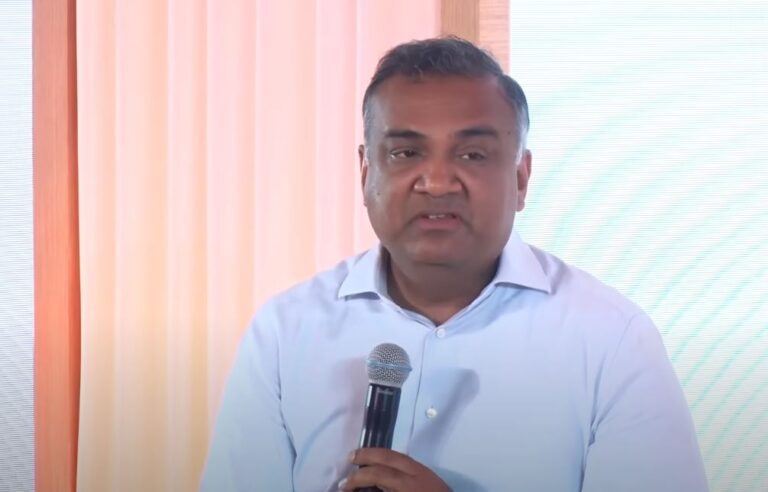The tech industry already knew they were looking at a seasoned digital strategy architect when Neal Mohan took over as head of YouTube in 2023, replacing Susan Wojcicki. His ability to successfully combine commercial success and product vision has proven to be remarkably effective over the years in guiding significant projects from conception to widespread adoption. The $155 million he commands in 2025 is the culmination of decades of building the most powerful platforms on the internet, not just his salary or stock.
Mohan’s path bears the dual imprint of Indian tenacity and American inventiveness. He was born in Lafayette, Indiana, and spent some time growing up in Lucknow, India. When Mohan talks about opportunity and ambition, the fact that his father only had $25 in his pocket when he arrived in the United States frequently strikes a chord. His particularly creative style of leadership, which combines calculated boldness with strategic patience, appears to have been fueled by this intensely personal background.
Neal Mohan Biography and Career Overview
| Category | Details |
|---|---|
| Full Name | Neal Mohan |
| Date of Birth | July 14, 1973 |
| Age | 52 years (as of 2025) |
| Birthplace | Lafayette, Indiana, USA |
| Nationality | American |
| Education | B.S. in Electrical Engineering – Stanford University; MBA – Stanford Graduate School of Business (Arjay Miller Scholar) |
| Current Position | CEO of YouTube (2023–Present) |
| Previous Roles | Chief Product Officer, YouTube (2015–2023); SVP Display & Video Ads, Google; VP Business Operations, DoubleClick |
| Major Projects | YouTube Shorts, YouTube Premium, YouTube Music, YouTube TV, YouTube Kids |
| Net Worth (2025) | Estimated $155 million |
| Spouse | Hema Sareen Mohan |
| Other Board Roles | Stitch Fix, 23andMe |
Mohan started his career at Accenture after graduating from Stanford with a degree in electrical engineering. He then made his first significant move to NetGravity, a startup developing early ad technology. His skill set was greatly expanded by that move, which combined operational leadership with technical expertise. Mohan made a smooth transition when DoubleClick purchased NetGravity, soon establishing himself as an indispensable figure in a tech era characterized by the dot-com crash.
He returned to Stanford for his MBA in 2003 after noticing that the industry was moving toward more advanced ad platforms. He became an Arjay Miller Scholar, a distinction only given to the best graduates. He also started working with David Rosenblatt at DoubleClick during this time, where they produced a 400-slide blueprint for the direction of advertising technology. That plan, which is still considered a masterwork of strategic clarity, influenced Google’s $3.1 billion 2007 acquisition of DoubleClick.
After joining Google, Mohan became a key figure in the company’s advertising empire, overseeing its Display & Video Ads division and leading its $85 million acquisition of Invite Media. When Twitter attempted to hire him in 2011, Google reportedly paid $100 million to retain him because of how highly valued his expertise was. This move significantly increased Google’s product momentum and continuity.
A pivotal moment occurred in 2015 when Mohan moved to YouTube as Chief Product Officer. His portfolio significantly grew in this area as he refined YouTube TV and introduced YouTube Premium, YouTube Music, and YouTube Kids. He enhanced recommendation algorithms and monetization tactics by utilizing advanced analytics, which greatly increased creator earnings. He led efforts to combat violent extremism on the platform during the pandemic, proving that in tech governance, profit and accountability can coexist.
Mohan inherited a platform at the epicenter of global culture when he took over as CEO in 2023. Under his direction, generative AI tools entered the platform’s creative ecosystem, YouTube Shorts took off, and television viewing emerged as the primary mode of consumption. His strategy, which emphasizes content security, product growth, and creator empowerment, is incredibly effective. These actions have positioned YouTube as an entertainment ecosystem that competes with established media behemoths, rather than just a platform for videos.
Mohan’s $155 million net worth is derived from a variety of sources, including executive compensation packages, stock options in Google and Alphabet, and board positions at 23andMe and Stitch Fix. Along with Sundar Pichai, Satya Nadella, and Shantanu Narayen, he is one of the highest-paid executives of Indian descent. He has, however, continued to project a modest public image while drawing attention to YouTube’s influence on the creative industries.
His recent social media interactions have demonstrated the platform’s impact, from praising The Sidemen for transforming friendship into a worldwide entertainment brand to congratulating MrBeast on reaching 400 million subscribers. The idea that YouTube’s value is in democratizing content creation is subtly reinforced by these instances.
Mohan’s rise also reflects a broader pattern: executives of Indian descent are changing the executive landscape in Silicon Valley. These leaders‘ ability to cross cultural boundaries, comprehend a variety of markets, and function in high-pressure, fast-paced settings is reflected in the trust that is placed in them. In a time when people’s attention spans are short but their desire for real content is unquenchable, Mohan has maintained YouTube’s relevance through strategic alliances and product foresight.
His path has wider ramifications. YouTube is influencing the way a new generation consumes entertainment and information as it vies for more television time. This change has cultural ramifications that impact media literacy, advertising models, and even politics. Mohan is placing a wager on a future in which audience engagement is driven by creators rather than by corporations by incorporating generative AI tools.
He stands out for having a very clear grasp of how technology, business, and cultural impact are all interconnected. Mohan’s tactics, whether they involve negotiating in the boardroom or introducing creator features, are based on both purpose and profitability. Perhaps his more enduring legacy will be the creative economy he helped create, where innovation flourishes and opportunities, like his own career, can start from almost anywhere. His net worth may increase significantly as the digital video landscape changes.

